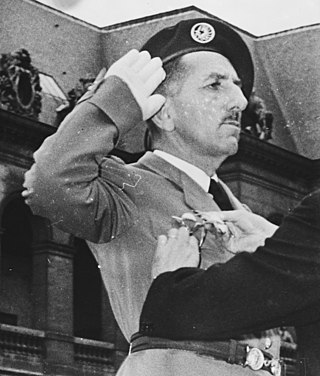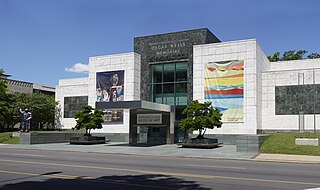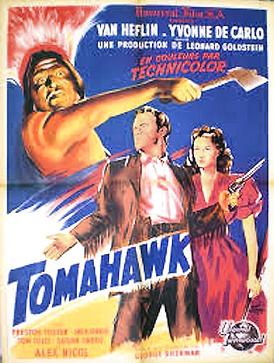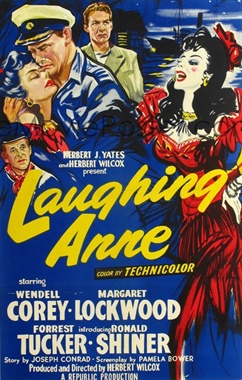
The Organisation armée secrète was a far-right French dissident paramilitary and terrorist organisation during the Algerian War. The OAS carried out terrorist attacks, including bombings and assassinations, in an attempt to prevent Algeria's independence from French colonial rule. Its motto was L’Algérie est française et le restera.

Pierre Eugène Jean Pflimlin was a French Christian Democrat politician who served as the Prime Minister of the Fourth Republic for a few weeks in 1958, before being replaced by Charles de Gaulle during the crisis of that year.

Wild Reeds is a 1994 French drama film directed by André Téchiné about the sexual awakening of four teenagers and their subsequent sensitive passage into adulthood at the end of the Algerian War. The film was selected as the French entry for the Best Foreign Language Film at the 67th Academy Awards, but not nominated.

Jacques Émile Massu was a French general who fought in World War II, the First Indochina War, the Algerian War and the Suez Crisis. He led French troops in the Battle of Algiers, first supporting and later denouncing their use of torture.

Dixie Wanda Hendrix was an American film and television actress.

Eric Harold Portman was an English stage and film actor. He is probably best remembered for his roles in three films for Michael Powell and Emeric Pressburger during the 1940s.

The Birmingham Museum of Art is a museum in Birmingham, Alabama. Its collection includes more than 24,000 paintings, sculptures, prints, drawings, and decorative arts representing various cultures, including Asian, European, American, African, Pre-Columbian, and Native American. The museum is also home to some Renaissance and Baroque paintings, sculptures,and decorative arts from the late 13th century to c. 1750.

Pierre Nora is a French historian elected to the Académie Française on 7 June 2001. He is known for his work on French identity and memory. His name is associated with the study of new history. He is the brother of the late Simon Nora, a former senior French administrative professional. He is the uncle of Olivier Nora, the president and publisher of the French publishing house Editions Grasset.

The Columbia Museum of Art is an art museum in the American city of Columbia, South Carolina.

Le Crabe-tambour (Drummer-Crab) is a 1977 French film directed by Pierre Schoendoerffer, based on the novel he published in 1976, which is inspired by the adventures of Commander Pierre Guillaume (1925-2002). It was translated into English by the maritime novelist Patrick O'Brian as The Paths of the Sea (1977). The film stars Jean Rochefort, Jacques Perrin and Claude Rich. Highly criticially acclaimed, it won three César Awards: Best Actor – Leading Role, Best Actor – Supporting Role and Best Cinematography and was nominated for three others.
Henri François Maillot was a pied-noir member of the Algerian Communist Party and participated in the Algerian War. In 1956, Maillot deserted from his military unit, taking with him an important stock of arms and ammunition for the guerrillas. He was killed in a battle against French forces near Orléansville two months later.

Algeria is the largest country in Africa; one of the main tourist attractions is the Sahara, the largest desert in the world. Algeria has been a member of the World Tourism Organization since 1976. According to a report of the World Tourism Organization published in 2014, Algeria was the 4th largest tourist destination in Africa in 2013 with 2.7 million foreign tourists, and ranks 111th on the international tourism scene, according to the London-based World Tourism and Travel Council (WTTC). The tourism sector in Algeria accounts for 3.9% of the volume of exports, 9.5% of the productive investment rate and 8.1% of the gross domestic product.

Jacques B. Brunius was a French actor, director and writer, who was born in Paris and died in Exeter, UK. He was cremated in Sidmouth, with a tribute by Mesens.

Lost Command is a 1966 American war film directed and produced by Mark Robson and starring Anthony Quinn, Alain Delon, George Segal, Michèle Morgan, Maurice Ronet and Claudia Cardinale. It is based on the best-selling 1960 novel The Centurions by Jean Lartéguy. The film focuses on the story of French paratroopers battling in French Indochina and French Algeria.

Tomahawk is a 1951 American Western film directed by George Sherman and starring Van Heflin and Yvonne De Carlo. The film is loosely based on events that took place in Wyoming in 1866 to 1868 around Fort Phil Kearny on the Bozeman Trail such as the Fetterman Fight and Wagon Box Fight. In the UK, the film was released as The Battle of Powder River.

The French conquest of Algeria took place between 1830 and 1903. In 1827, an argument between Hussein Dey, the ruler of the Regency of Algiers, and the French consul escalated into a blockade, following which the July Monarchy of France invaded and quickly seized Algiers in 1830, and seized other coastal communities. Amid internal political strife in France, decisions were repeatedly taken to retain control of the territory, and additional military forces were brought in over the following years to quell resistance in the interior of the country.

Laughing Anne is a 1953 British adventure film directed by Herbert Wilcox and starring Wendell Corey, Margaret Lockwood, Forrest Tucker, and Ronald Shiner. It was adapted from Joseph Conrad's short story, "Because of the Dollars" and from his 1923 two-act play, Laughing Anne. The film was shot at Shepperton Studios outside London. The film's sets were designed by the art director William C. Andrews and costumes were by Elizabeth Haffenden.

Baron Charles Frédéric Chassériau du Chiron was a Saint Dominican architect and painter, who served as chief architect of the cities of Marseille, Algiers, in Algeria; and Cairo, in Egypt. He is particularly known for having designed the seafront of the city of Algiers.

The National Museum of Fine Arts in Algiers is one of the largest art museums in Africa. Opened to the public since 5 May 1930, it is located in the Hamma district, next to the Hamma test garden.

Paul Flatters was a French soldier who spent a long period as a military administrator in Algeria. He is known as leader of the Flatters expedition, an ill-fated attempt to explore the route of a proposed Trans-Saharan railway from Algeria to the Sudan. Almost all members of the expedition were massacred by hostile Tuaregs. The survivors resorted to eating grass and to cannibalism on the long retreat through the desert. After a brief outburst of public indignation the fiasco was forgotten.



















